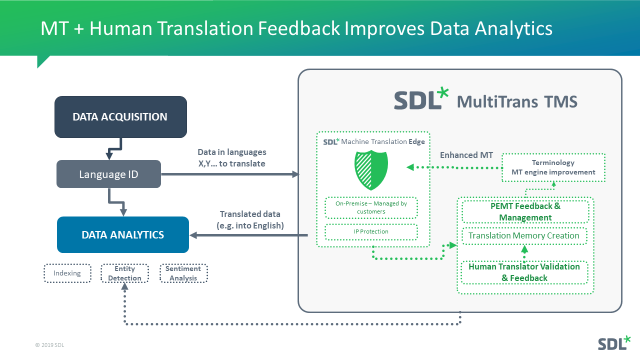Efficient and effective multilingual eDiscovery practices

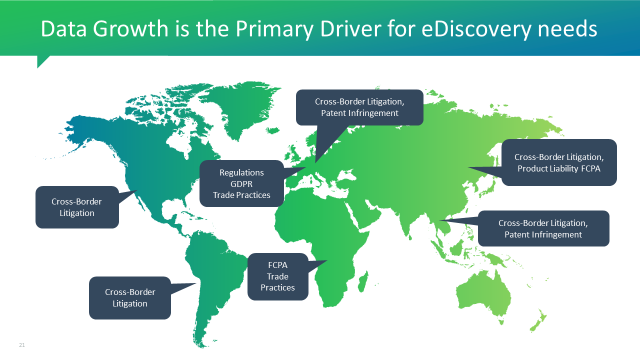
What is eDiscovery?
Electronic discovery (sometimes known as e-discovery, eDiscovery, or e-Discovery) is the electronic aspect of identifying, collecting and producing electronically stored information (ESI) in response to a request for production in a lawsuit or internal corporate investigation. ESI includes, but is not limited to, emails, documents, presentations, databases, voicemail, audio and video files, social media content, and websites.
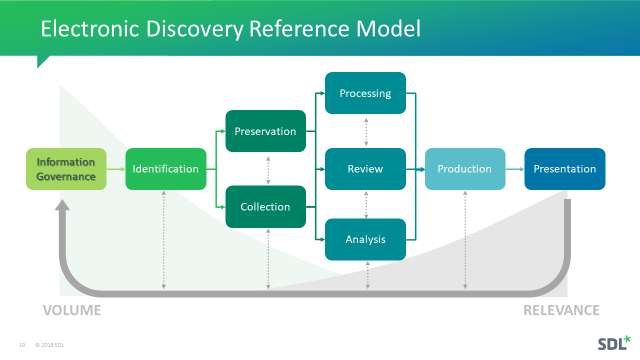
The processes and technologies around eDiscovery are often complex because of the sheer volume/variety of electronic data produced and stored. Additionally, unlike hard-copy evidence, electronic documents are more dynamic and often contain metadata such as time-date stamps, author and recipient information, and file properties. Preserving the original content and metadata for electronically stored information is required to eliminate claims of spoliation or tampering with evidence later in a litigation scenario.
EDiscovery is typically a culling process, of moving from unstructured to structured data – from unstructured data to matter specific relevance, and the highest value and most directly relevant information.
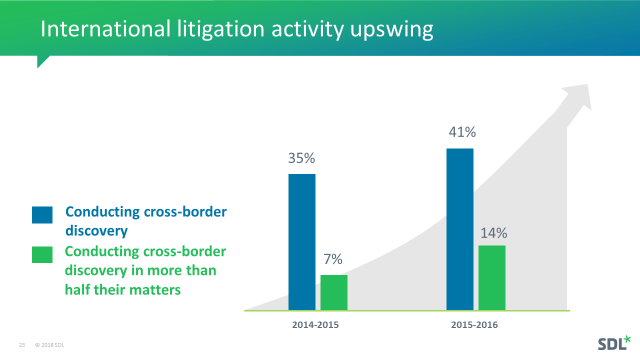
Thus, while there are three primary activities typically in eDiscovery, namely, collection, processing, and review, it is clear to practitioners and analysts that the review-related activity is the bulk of the cost of the overall eDiscovery process.
One analyst estimates that review-related software and services are estimated to constitute approximately 70% of worldwide eDiscovery software and services spending in 2018. While the percentage of spending for the eDiscovery task of review is estimated to decrease to around 65% of overall eDiscovery spending through 2023, the overall spend in dollars for eDiscovery review is estimated to grow to $12.15B by 2023.
A respected RAND Institute study is even more explicit about the costs and shows very clearly that managing your data volume is critical to managing your costs. The Rand Institute for Civil Justice estimates that the per-gigabyte costs break down to $125 to $6,700 for collection, $600 to $6,000 for processing, and, in the most expensive stage, $1,800 to $210,000 for review. The costs for multilingual review are very likely even higher and by some estimates could be as much as 3X times higher.
"The RAND Institute for Civil Justice has estimated that each gigabyte of data reviewed costs a company approximately $18,000."
This means that a conscientious, defensible, proactive approach to information governance can lead to tremendous savings. Every gigabyte of outdated unnecessary ESI that you delete in following a uniform data destruction policy saves you, on average, $18,000 per case.
What is document review?
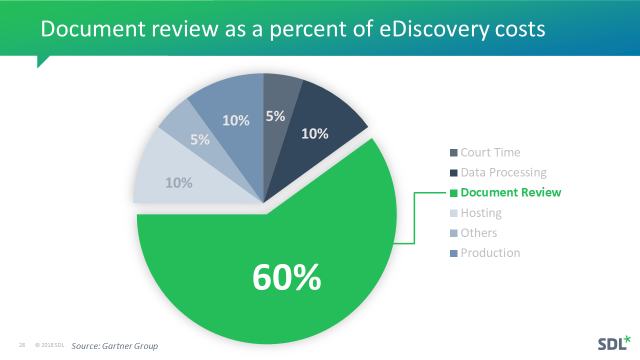
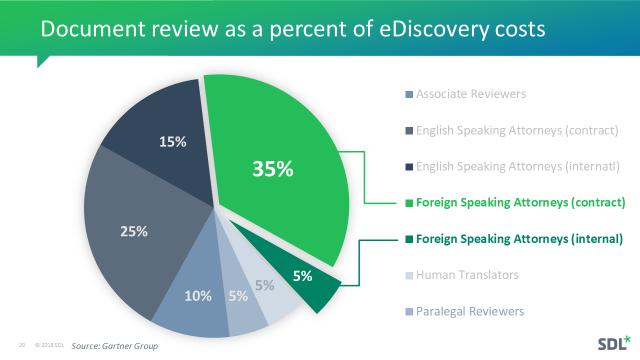
The SDL Multilingual eDiscovery process
It is possible to identify the key steps involved in a typical multilingual eDiscovery use case where the key objective is to extract the most relevant information form a large volume of submitted material. The multilingual characteristics of much of the data that needs to be reviewed today adds a significant layer of complexity and additional cost to the process.
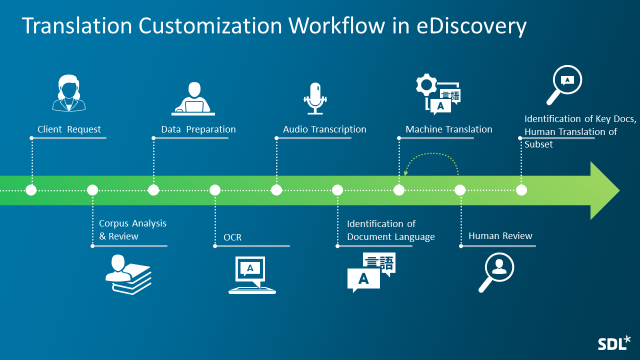
The typical process involves the following key steps:
- Text Extraction: It is often necessary to extract multilingual text from scanned documents to ensure that all relevant documents are identified and sent to review. SDL has leading-edge OCR technology and native file processing technology to enable an enterprise to do this at scale. Sometimes it is also required to extract text from audio.
- Automated Language Identification Processing: SDL’s Linguistic AI technology capabilities make automatic detection of languages and data sets within any content an efficient and highly automated process.
- Multilingual Search Term Optimization: SDL linguists work together with MT experts to generate critical search and terminology to ensure that multilingual data goes through optimal discovery related processing. This ensures that high volume automatic translations get critical terminology correct, and also enables the most relevant foreign language data to be discovered and presented for timely review. The multilingual search term consultant’s understanding of linguistic and cultural nuances can mean the difference between capturing critical information and missing it completely. SDL linguists ensure that grammatical, linguistic and cultural issues are taken into consideration during search term list development.
- Secure Translation Management Infrastructure: SDL’s multilingual eDiscovery solution connects the SDL MultiTrans® Translation Management System (TMS) to Relativity®, a popular eDiscovery cloud solution for case management. We will continue to expand our connectivity to other information governance and discovery tools as per market demands. The connection between the two platforms helps legal professionals and internal investigators to quickly navigate and classify foreign language documents, and seamlessly request specialized human language translation services when they deal with multilingual assets. Translate large volumes of documents in a fraction of the time. SDL MultiTrans is secured using certified SSL technology, and on premise solutions to ensure the data never leaves the corporate network, preventing information leaks. SDL MultiTrans is a leading translation management system, securely streamlining and enhancing every aspect of an organization’s translation and localization process, and allowing project managers and translators to complete projects faster, far more efficiently, and to the highest standards.
- Secure, Private, State-of-the-Art Machine Translation: SDL is a leader in developing secure, private, scalable enterprise-ready MT technology that can be deployed on premise or in the private cloud, and related expert services. SDL’s MT technology is used by the largest global enterprises in the world, as well as many governmental agencies focused on national security and intelligence gathering activities. Our partnership with Relativity (and other eDiscovery platforms) makes it easy for companies to handle anything related to large corporate legal matters, from analyzing and translating millions of documents to preparing critical contracts and court-presentable documents.
- Specialized Human Translation Services: SDL provides an around-the-clock, around-the-world service using state-of-the-art linguistic AI tools to ensure greater accuracy, security, reduced costs and turnaround time. The company has a pool of certified and specialized translators across multiple jurisdictions and languages worldwide who have expertise and competence across a wide range of legal documents. The company is already working with 19 of the top 20 law firms in the world. The translation supply chain is often the hidden weak spot in an organization's data compliance. SDL’s secure translation supply chain gives you fully auditable, data custody of your translation processes and can be cascaded down through your outside counsel and consultants to create a replicable process across all of your legal service partners.
